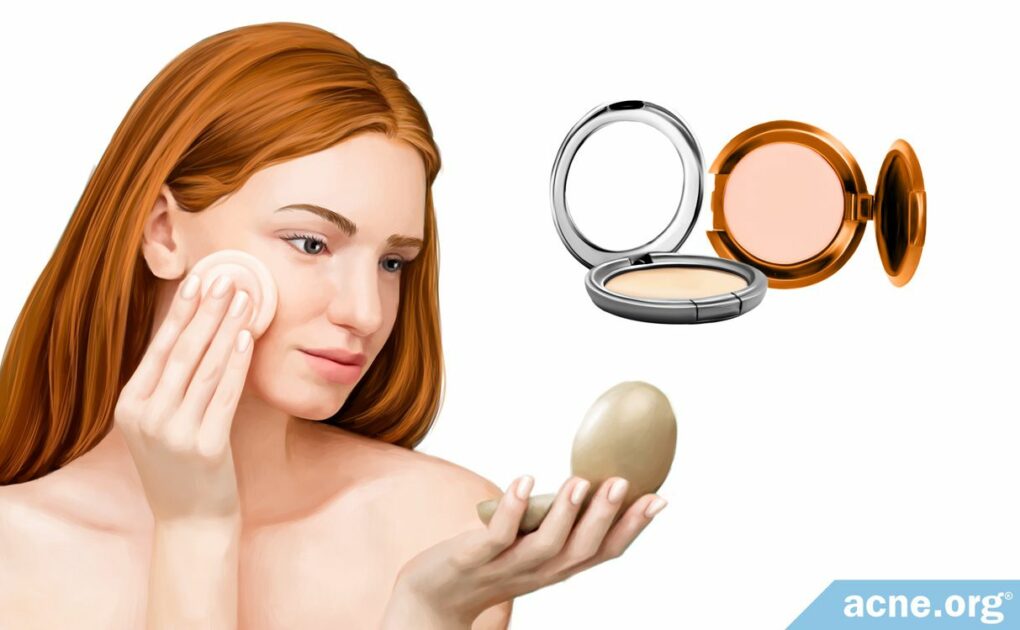Select a Face Powder That Does Not Contain Any Pore-clogging Ingredients and Apply It Very Gently

The Essential Info
When selecting a face powder, look at the ingredients. Avoid face powders that contain pore-clogging ingredients.
To be on the safe side, also avoid fragranced powders, because fragrances may irritate the skin or cause allergies in some people.
Important Considerations When Using Face Powder
- Apply it gently: To avoid physically irritating your skin, stay as ultra-gentle as possible when applying face powder.
- Remove makeup before bed: Very gently remove all makeup before bed.
- Don’t use expired makeup: It’s safest to only use fresh makeup.

The Science
- Guidelines for Choosing a Face Powder for Acne-prone Skin
- List of Common Comedogenic Ingredients in Makeup
- Tips for Using Face Powder on Acne-prone Skin
Face powder can come in a loose or pressed powder and can be either translucent or pigmented. Regardless of the exact type of powder, all powders all aim to:
- Set foundation (fixes the foundation in place)
- Absorb excess oil from the skin
- Give the skin a smooth and polished appearance
- Even out the skin tone, in the case of pigmented powder1
Since makeup can potentially contribute to acne,2 people with acne-prone skin need to be careful when selecting face powders or other makeup products.
Guidelines for Choosing a Face Powder for Acne-prone Skin
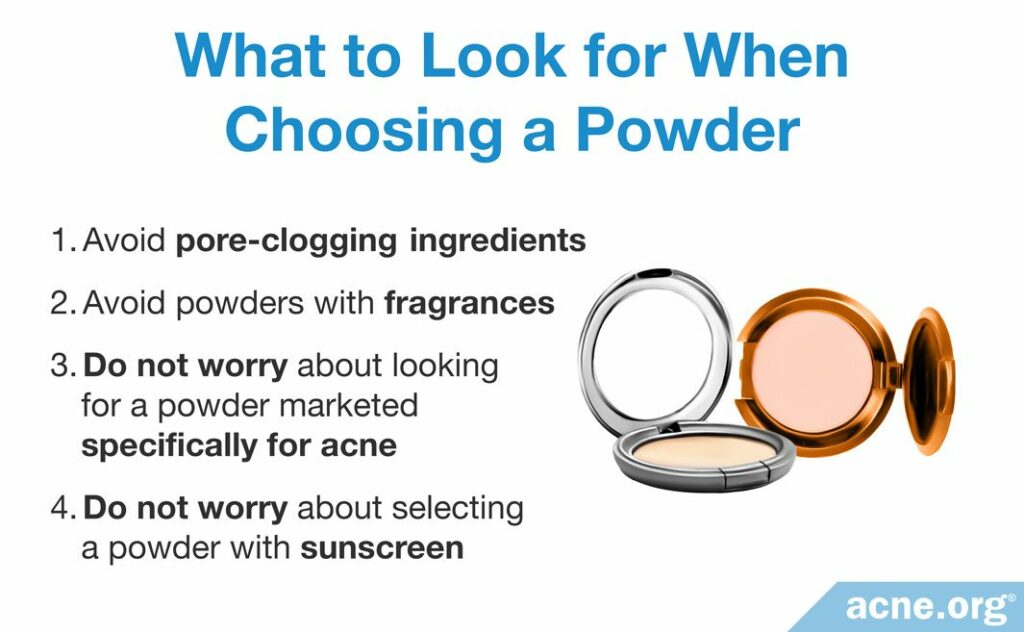
- Avoid pore-clogging ingredients: Before buying a face powder, check the ingredient list first. Steer clear of face powders that contain comedogenic (pore-clogging) ingredients. The table below shows a comprehensive list of common comedogenic ingredients.
- Avoid face powders with fragrances: Fragrances are the ingredient most likely to cause allergies. Even if you are not allergic to fragrances, they may irritate your skin and thus aggravate worse. The best approach is to select a fragrance-free face powder.
- Do not worry about looking for a face powder marketed specifically for acne: Some manufacturers produce face powders for acne-prone skin by adding salicylic acid, a common over-the-counter anti-acne active ingredient. Salicylic acid is somewhat beneficial for acne-prone skin, but the amount of salicylic acid that can reach the skin from a face powder is negligible. Do not worry about finding a face powder that has this ingredient.
- Do not worry about selecting a face powder with sunscreen: Some face powders contain sunscreen, but the amount of face powder that most people use is too small to adequately protect the skin from the sun’s rays. Therefore, do not worry about looking for a face powder that contains sunscreen.
List of Common Comedogenic Ingredients in Makeup
Many research studies have investigated how likely various ingredients are to cause clogged pores (comedones).2 We have thoroughly reviewed these studies and compiled two lists:
- Definitely avoid: These are ingredients that people with acne-prone skin should definitely avoid, because a solid body of evidence indicates that they are comedogenic.
- Consider avoiding: These are ingredients that people with acne-prone skin may want to consider avoiding, because some evidence indicates that they might be comedogenic.
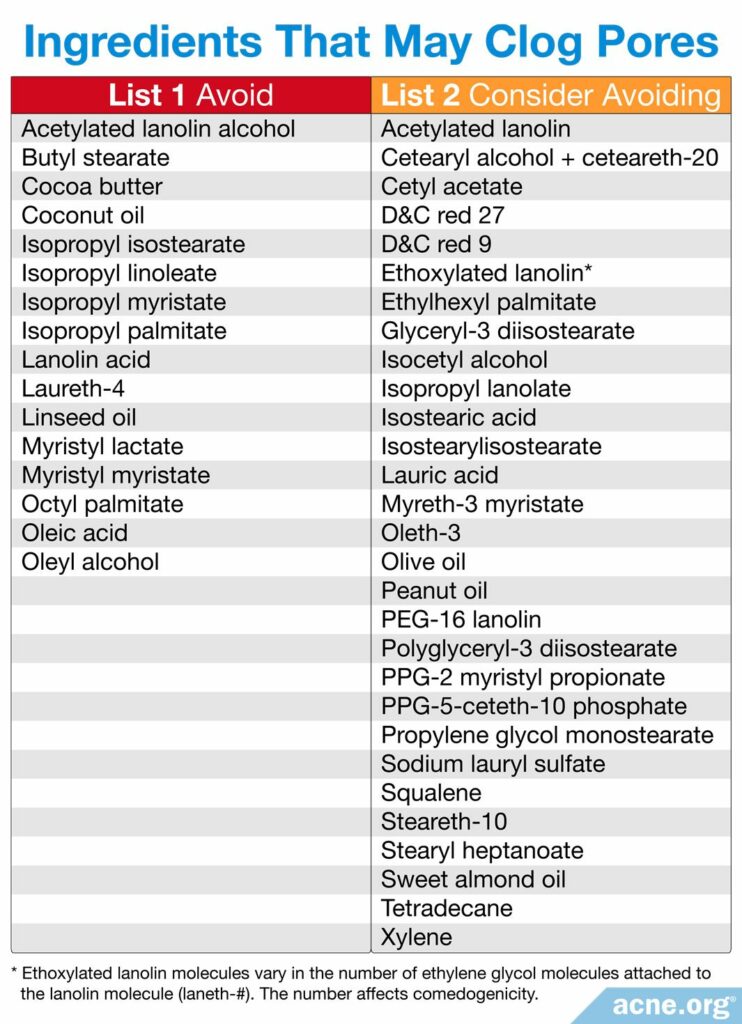
Tips for Using Face Powder on Acne-prone Skin
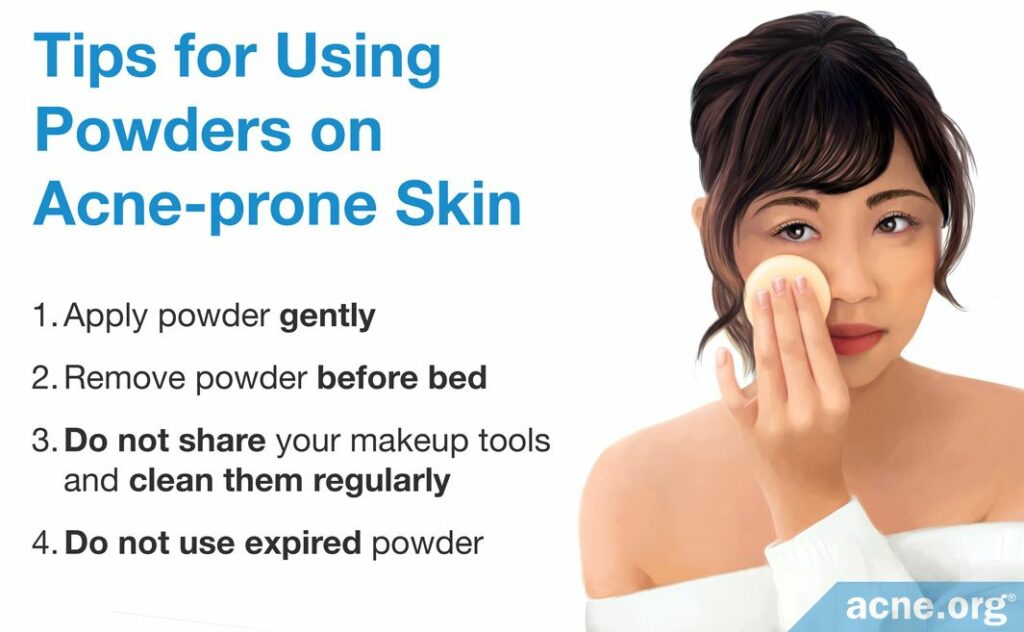
Whenever you apply face powder or any other makeup to acne-prone skin, avoid irritating the skin, because physical irritation of the skin can make acne worse. It is also essential to practice good hygiene in order to prevent skin infections. Keep these tips in mind when you use face powder on acne-prone skin:
- Apply face powder gently: To avoid irritating the skin, apply face powder very gently. Use a powder puff to apply powder with gentle tapping motions, or select the softest makeup brushes.
- Remove face powder before bed: Since the skin is more vulnerable at night, it is important to remove face powder and any other makeup before you go to bed. Be gentle when you remove makeup so as not to irritate your skin.
- Do not share your makeup tools and clean them regularly: Do not share your sponges, brushes, or powder puffs with anyone, because sharing makeup tools increases your chances of contracting a skin infection. Select disposable tools or clean them regularly to prevent the growth of bacteria and mold.
- Do not use expired face powder: A face powder that is past its expiration date may harbor bacteria or begin to degrade. Never use makeup that has expired.
Face Powder Ingredients: The Full Scoop
Face powder is a makeup product that can be applied on top of foundation in order to set the foundation (fix it in place). In addition, face powder absorbs excess oil and gives the skin a smooth and polished look.1
Types of face powder
When it comes to color, there are two types of face powder:
1. Translucent face powder: This type of powder looks white in the makeup container, but turns invisible on the skin. It absorbs excess oil, but does not change the skin tone.
2. Pigmented face powder: This type of powder comes in a variety of shades. In addition to absorbing excess oil, it also evens out the skin tone.1
When it comes to physical properties, there also two types of face powder:
- Pressed powder
- Loose powder
While women have used loose face powder for centuries, pressed powder first appeared on the American market in the 1930s. Pressed powder has the advantage of convenience, as it is easy to carry in a handbag and to use for fast touch-ups throughout the day.1,3
Face powder ingredients
Both pressed and loose powders share the same main ingredients.3,4 The key difference between them is that pressed powders contain binding agents, or binders, while loose powders do not. Binders allow good compression of the powder into a cake without crumbling.3
Some of these ingredient types are marked with an asterisk (*) because they may be comedogenic or irritating. Before buying a face powder, take a look at the list of ingredients and ensure that none of them appear in the list of comedogenic ingredients at the beginning of this article.
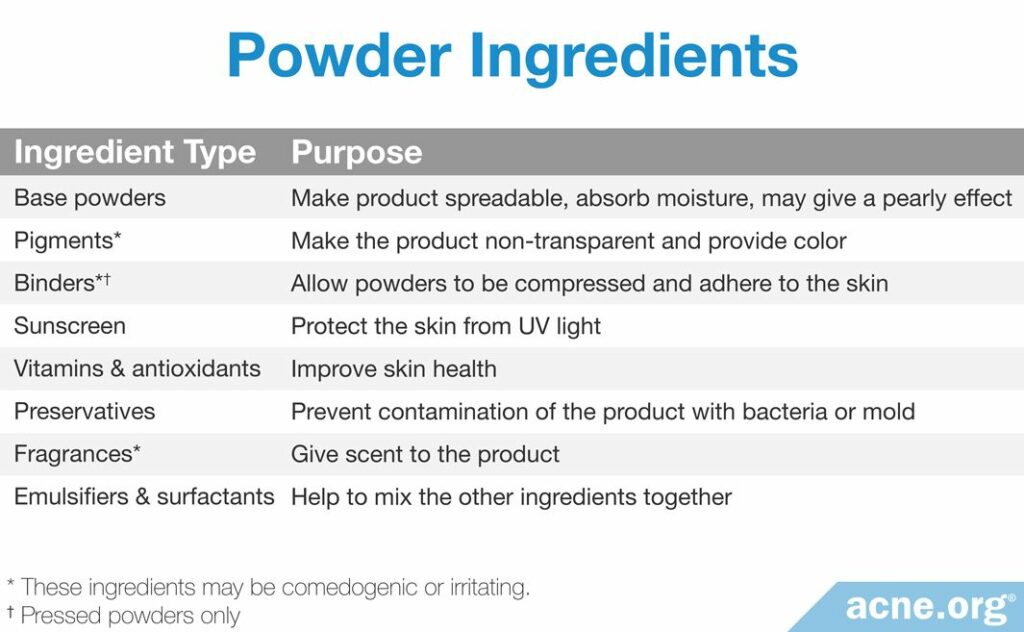
Sunscreen in face powder
If you spend a lot of time outdoors and in the sun, protecting your skin from the sun’s rays is always a good idea. Excessive sun exposure can lead to sunburn, and in people with acne, it can also contribute to so-called post-inflammatory hyperpigmentation (darkening of acne lesions after they heal). Therefore, it is good practice to wear either sunscreen or a tinted moisturizer or foundation that contains broad-spectrum sunscreen. Even if your face powder contains sunscreen (often titanium dioxide), face powder alone will not provide adequate sun protection for your face, because most people only use a small amount of face powder.
Salicylic acid in face powder
Some face powders contain salicylic acid, which is somewhat beneficial for acne-prone skin. However, over-the-counter products like makeup are legally only allowed to contain a small amount of salicylic acid: 2% at most. At this low concentration, salicylic acid in your face powder is unlikely to dramatically improve acne. Moreover, most people only apply a small quantity of face powder, so the amount of salicylic acid that reaches the skin is negligible. In other words, while it does not hurt to have salicylic acid in your face powder, it is probably not worth searching for a face powder with this ingredient.
References
- Available from: https://en.wikipedia.org/wiki/Face_powder. Accessed on 14/08/2017.
- Katoulis A. C., Kakepis E. M., Kintziou H., Kakepis M. E. & Stavrianeas N. G., Comedogenicity of cosmetics: a review, Journal of the European Academy of Dermatology and Venereology, 7, 115-119 (1996). https://onlinelibrary.wiley.com/doi/abs/10.1111/j.1468-3083.1996.tb00606.x
- Riley, P. Decorative cosmetics. (2000). In: Poucher’s Perfumes, Cosmetics and Soaps, 10th Edition. Kluwer Academic Publishers. 166-184. http://priede.bf.lu.lv/grozs/AuguFiziologijas/Augu_resursu_biologija/gramatas/Perfumes%20Cosmetics%20Soaps.pdf
- Valet, B., Mayor, M., Fitoussi, F., Capellier, R. Dormoy, M. & Ginestar J. (2007). Colouring Agents in Decorative and other Cosmetics. In: Analytical Methods Analysis of Cosmetic Products, 1st Edition. Elsevier 145-148 https://kundoc.com/pdf-colouring-agents-in-cosmetic-products-excluding-hair-dyes-.html
 Acne.org Products
Acne.org Products